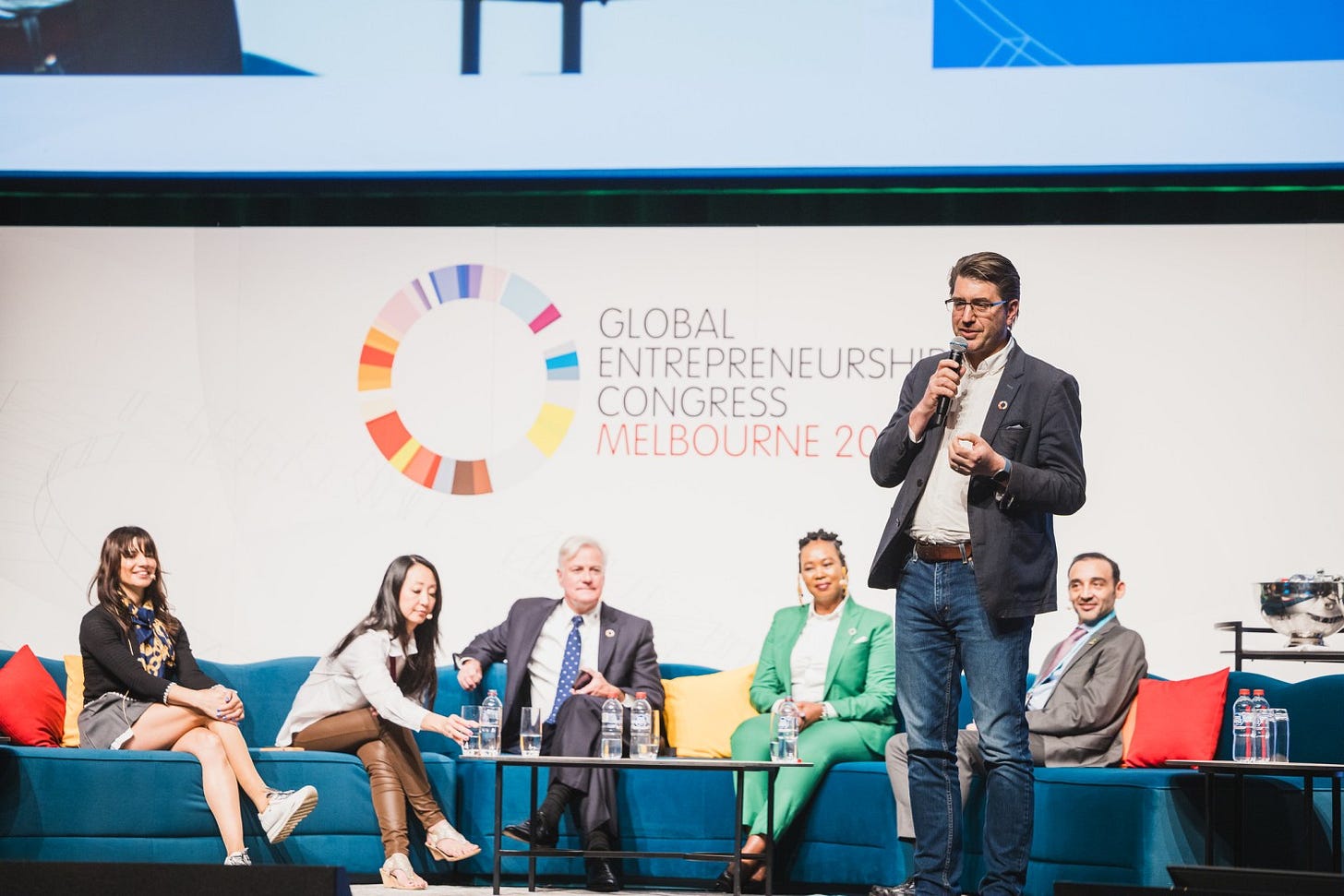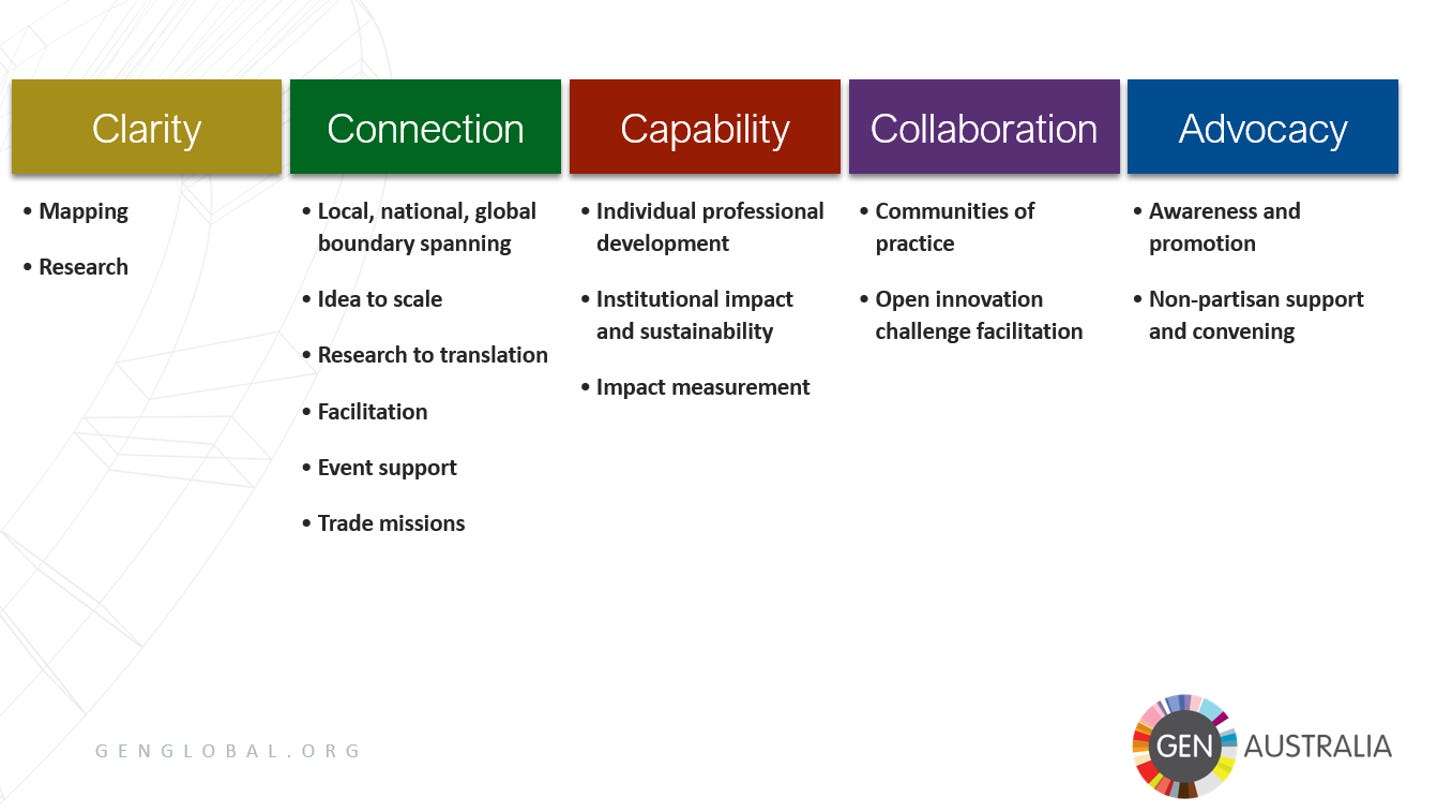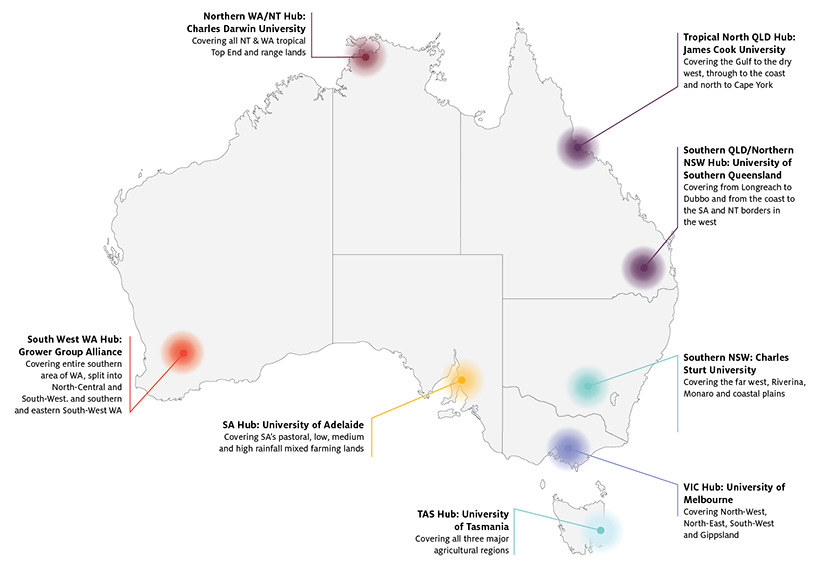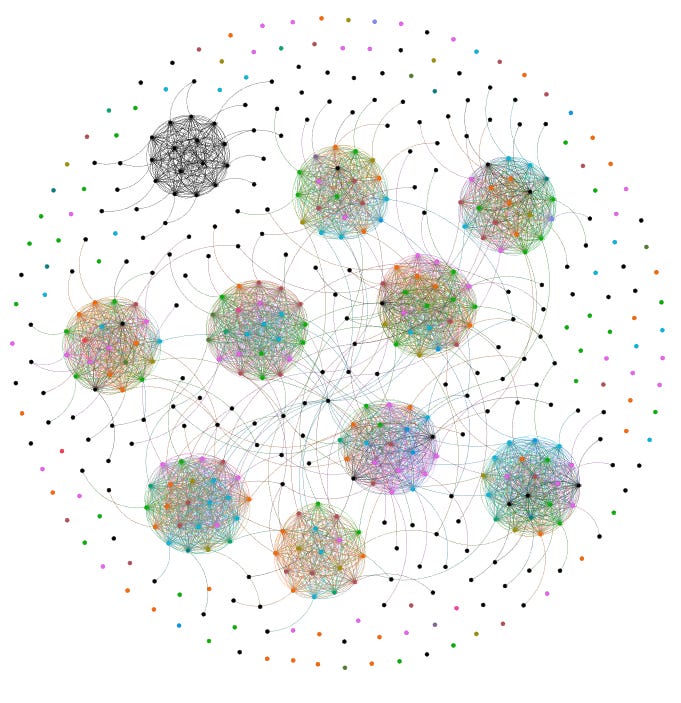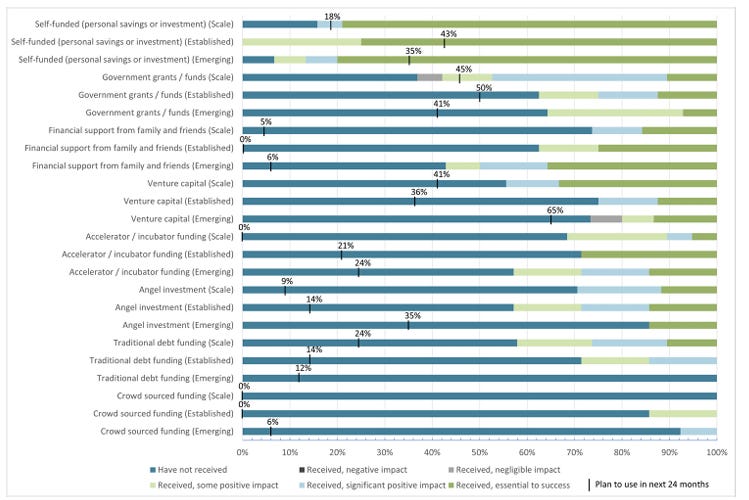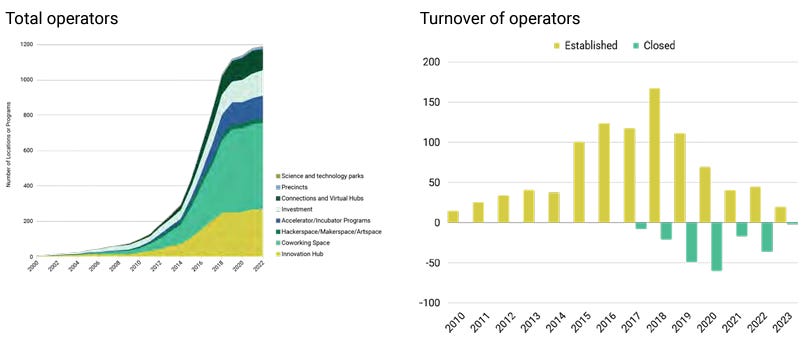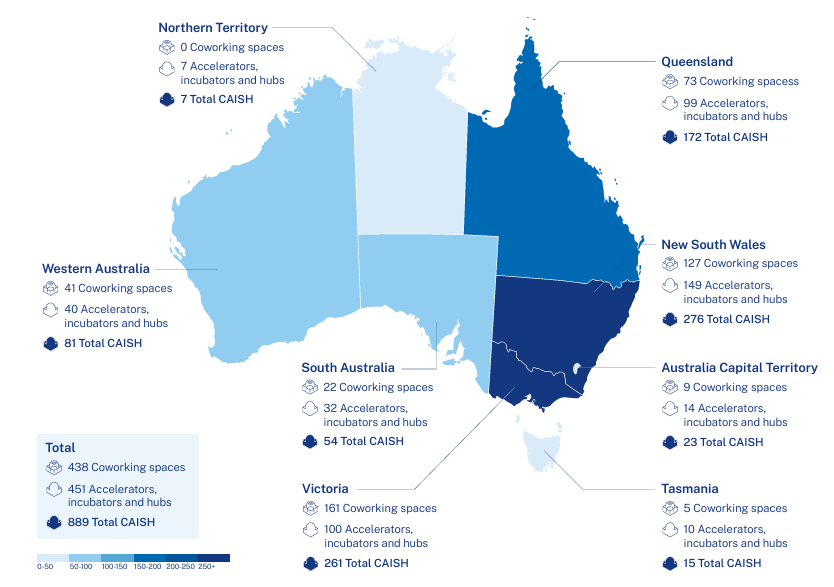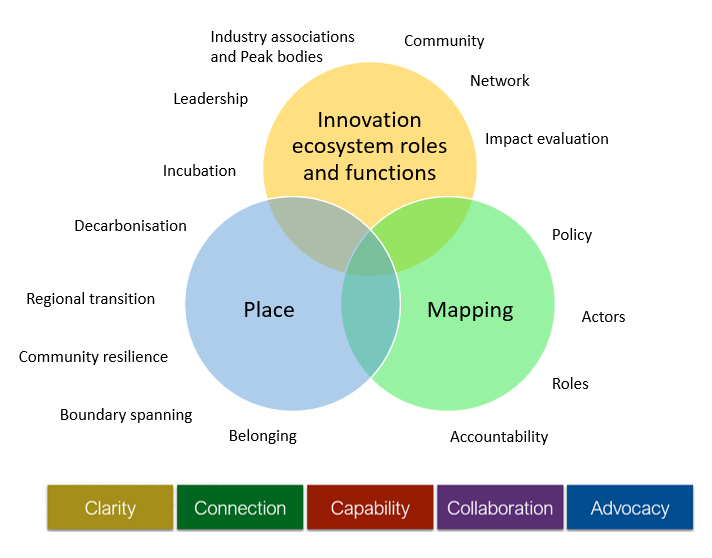Working in the Australian innovation ecosystem: 2023 reflections & 2024 projections
Taking advantage of the last of the holiday downtime to capture last-year reflections and next-year projections. Also a reference point for those who ask "What exactly is it that you do?"
They say an unreflected experience is a lost experience. I also believe there is value in sharing journeys for collective learning and attracting others on aligned journeys so we can have more impact together. With this in mind as we head into a New Year, here are some thoughts on how I got here, what happened, and what it means moving forward.
Over thirty years ago, I could not predict a vocation in the Australian innovation ecosystem. But here I am in a portfolio career that has emerged over the past decade to support innovation and entrepreneurship across Australia.
My portfolio has settled into three main roles. My primary role is as a Research Fellow (Innovation Ecosystems) with the Rural Economies Centre of Excellence at UniSQ where I apply the work started in my PhD to build community resilience in rural economies through innovation ecosystems. I work with an amazing group of colleagues including Centre Director A.Prof Ben Lyons, Marlyn McInnerney, Geoff Woolcock, Fynn De Daunton, and Saleena Ham, PhD.
In my second prominent role, I develop technology to map and measure the impacts of the innovation ecosystem through the not-for-profit Startup Status. Third and more recently, my role as the Managing Director for the Global Entrepreneurship Network Australia focuses on addressing systemic challenges nationally and through global connectivity.
The three roles intersect well in what I consider more of a vocation and a calling than a profession. Around ten years back I set my intent on addressing contributing factors to systemic and embedded inequality. That intent combined with a curiosity for innovation and a background in applied social science and business has me on a journey in local and national innovation ecosystem building. My future work supports place-based development of innovation and entrepreneurship while addressing centralised wealth and inequality associated with rapid industrial advancement.
The intent forms the "why" of my actions - my personal 'theory of change' that connects my activities to my outcome and impact. The focus also brings me in contact with others who are doing amazing work I can learn from and support.
2023: The year that was
Global Entrepreneurship Congress
My 2023, indeed the majority of my past two years, has been defined by the Melbourne 2023 Global Entrepreneurship Congress held in September. I shared in a previous post a few insights on activities and outcomes from the process of bringing around 2,500 delegates from around the world to build 'one global entrepreneur ecosystem.
The greatest personal impact from the event was in the period from March to November 2022, engaging with over 500 leaders across 30 focus areas of the innovation ecosystem by dimensions of sector, impact, technology, and function. Like an anamorphic art piece that provides new meaning when seen from a different perspective, the work with the over 20 stream leads in each area defined a five-point framework of clarity, connection, capability, collaboration, and advocacy.
I am grateful for an amazing GEN Australia board coming out of the GEC that includes Julia Spicer OAM, Andy Stoll, Laxmi Pun, Matthew Salier, and Peter Komives and alongside Grant Downie. We came away with 2024 support for GEN programs of the Entrepreneurship World Cup and Global Entrepreneurship Week, and recipient of the GEN Global Research Champion Award.
The GEC was not without challenges and we took time after the event to refresh, reflect, and plan the next steps. We are now taking lessons from the GEC and applying them towards a ten-year program for local impact with national application.
Southern Queensland / Northern New South Wales Future Drought Fund Drought Innovation Hub Evaluation
Value from innovation and entrepreneurship is realised when applied to focused and relevant challenges. In 2021, the federal Future Drought Fund established eight innovation hubs across Australia to focus on the shared, complex challenge of response to drought. Each hub includes up to 6 geographic nodes and 30 to 50 collaborative partners.
The national initiative effectively created over 40 place-based drought-focused incubators over a few months. The significance of the effort should not be understated. As a reference point, around 15 innovation hubs were created per month at the peak growth of Australian innovation assets in 2018.
Through the Rural Economies Centre of Excellence at UniSQ, I manage the Monitoring, Evaluation, and Learning (MEL) framework for the Southern Queensland / Northern New South Wales Drought Innovation Hub. The Hub based out of UniSQ in Toowoomba supports six nodes: three in Queensland at Roma, Longreach, and Stanthorpe, and three in New South Wales at Lismore, Narrabri, and a dedicated hub at Armidale.
The project is complex due to the distributed nature of the portfolio of over 60 initiatives and 160 events in the six nodes. The initiatives are diverse across the hub's strategic focus areas of data and decision-making, wellbeing and employability, environmental commodities, and best-practice agriculture. Working with a national evaluation community of practice has been rewarding as we collaborate on approaches to evaluate the impact across the eight hubs. We are applying lessons from the first two years to expand on the evaluation framework for 2024.
Leadership program evaluation: Australian Rural Leadership Program
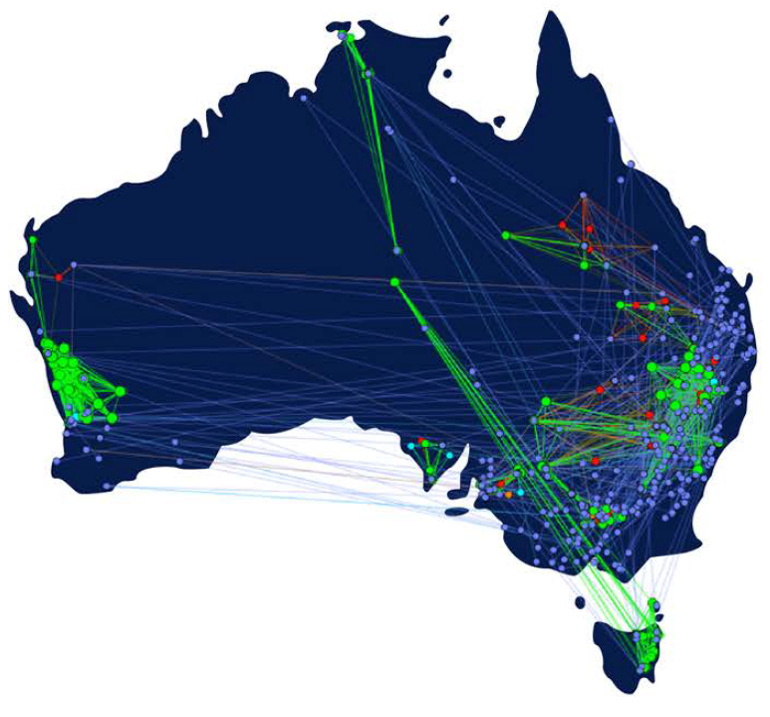
We were also involved in evaluating another Future Drought Fund initiative, the Australian Rural Leadership Foundation's Drought Resilient Leaders program. The program invested in leadership cohorts across Australia through a residential training program, a national mentoring framework, and collaborative grant funding. The evaluation assessed the development of practical leadership skills, leadership characteristics, responses to drought leadership, and personal, professional, community, and collective impacts.
A key insight from the evaluation was the value of building multiple streams in an intervention. Participants reported increased outcomes if they engaged in multiple aspects of the program, be it mentoring and leadership development, mentoring and grant projects, and/or leadership development and mentoring.
In this way, the structure of the program reflected characteristics of what is often seen in an entrepreneurial accelerator: personal development with leadership and domain-specific content, boundary-spanning mentors, and funding to help the participant advance passion projects and build a team. The insights inform future evaluation to assess the long-term impacts of integrated interventions.
In addition to the value for individual participants, another insight was in the value found in the national, integrated alumni network. Leadership programs create a shared language and mindset. Long-term investment in these networks creates a national asset for collective impact towards complex challenges and opportunities.
Place-based development: Burnett Inland
We are fortunate to work at global, national, and local levels. In 2022, we supported the Red Earth Community Foundation's Burnett Inland Futures report. The work highlighted the need to support future regional transition, respond to inequality in innovation infrastructure investment, and establish a supporting backbone structure to facilitate collective impact in the region.
In 2023, we continued to support the region with research into the ten-year impact of the Foundation's Community Leadership Program. Community leadership development programs are delivered across regional Australia, supported by Regional Development Australia, Chambers of Commerce, local facilitators, and Community Foundations. The research to be released in 2024 will explore the collective impact contributions from leadership program alumni and networks and the role of community foundations in contributing to local leadership capacity and community resilience.
Surveys, platforms, reporting, and papers
Innovation representation can be a challenge due to not being a sector on its own but rather integrated across sectors. Industry peak bodies are essential to provide advocacy, research, and representation of individual sectors. Over the past several years, we have seen the emergence of industry bodies focused on agritech, fintech, interactive games, blockchain, cyber security, artificial intelligence, flexible workspaces, and climate-tech, as well as the evolution of the Technology Council of Australia from StartupAus. It is important to support these industry bodies with accurate and reliable data to ensure they represent the scale and needs of their constituents to policymakers and the public.
We had the opportunity to support AusAgriTech with a member survey integrated into a data-driven ecosystem map and industry report. The report included a policy scan to review state and federal Agritech policy support and insights into the needs and projections of Agritech businesses based on stage and business model. A key takeaway was differences in the projected economic contribution of future jobs and the value of received ecosystem support between emerging, scaling, and established businesses.
We also contributed data sets for the 2023 Flexible Workspace Australia report following an update of incubator entries and exits. The report highlights the impact of the COVID-19 pandemic, with 56% of all closures of incubator spaces in the past ten years happening in the two years of the pandemic.
We collaborated with UTS to provide a report for New South Wales on Accelerating NSW: the impact of coworking spaces, accelerators, incubators, and startup hubs. The report included a breakdown of incubation by state and territory and a focus on regional distribution across NSW.
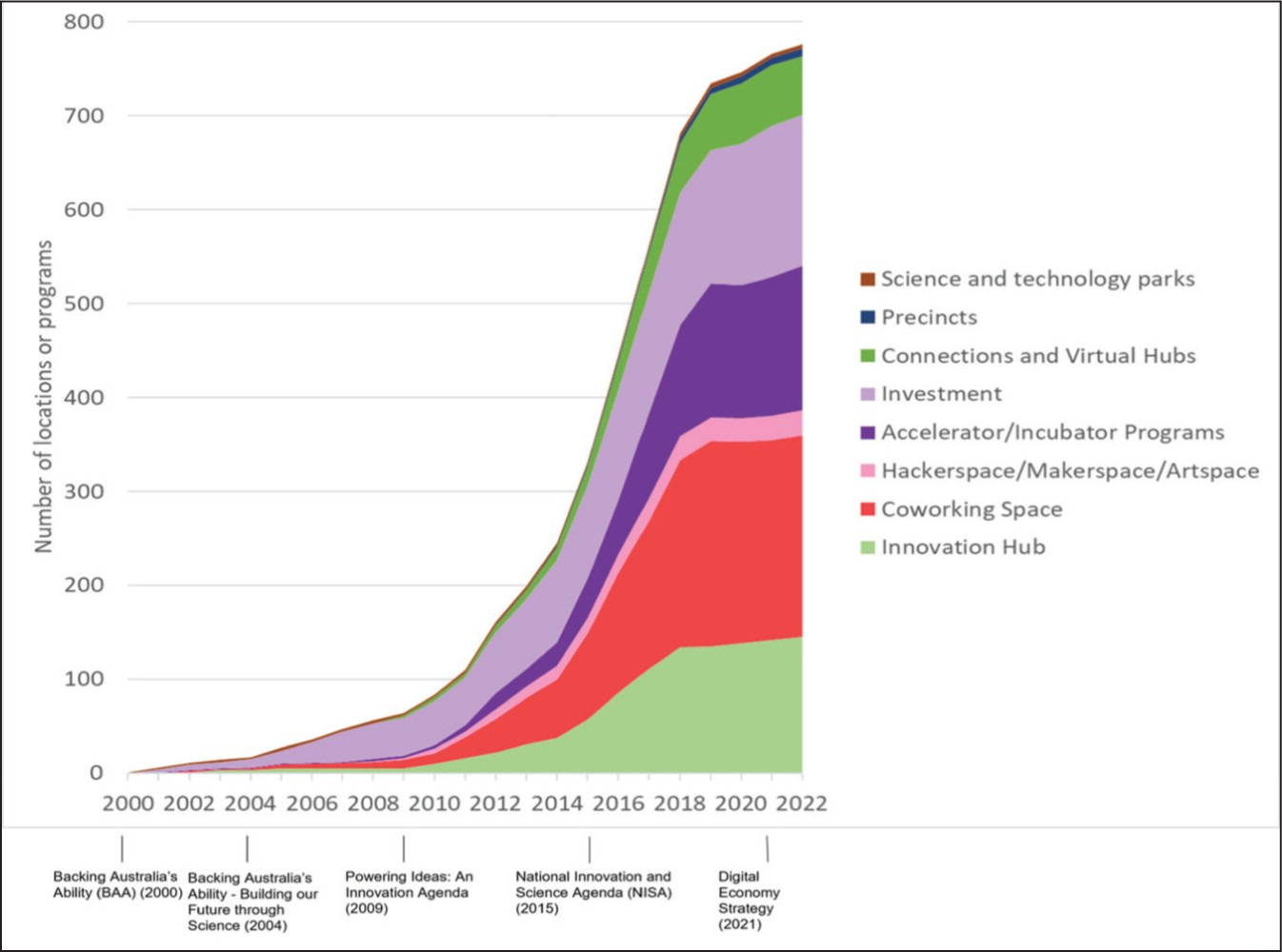
In addition to industry reports, I am working on journal publications from ongoing research and publishing from my PhD thesis. I worked with Dilek Cetindamar, Martin Bliemel, and Saskia de Klerk to publish The Evolution of the Australian Start-up and Innovation Ecosystem: Mapping Policy Developments, Key Actors, Activities, and Artefacts in October in Science, Technology and Society. The paper examines the contribution of policy towards the growth of the Australian innovation ecosystem.
PhD supervision
I still feel relatively new to the university sector having completed my own PhD only a few years back. But one of the aspects of university life I do enjoy is the opportunity to give back through supervising new PhD candidates. The process is rewarding in that you learn from and lead aspiring leaders and researchers who share complementary and diverse passions.
In 2023 I had the opportunity to support research into the topic of AgTech adoption specific to temperature control. The research raised insights into structural, social, and institutional barriers to adoption that have little to do with the technology itself.
Other candidates being considered include a focus on the renewable energy workforce and veteran entrepreneurship support. I am keen to chat if you are considering a PhD in fields related to innovation and particularly innovation ecosystems.
As a supervisor, you will find I am not overly academic but more focused on the practical, entrepreneurial, and commercial outcomes of your efforts. I see coming out of a PhD with a business as much as a win as journal papers. Both are better.
Looking ahead to 2024
The work we do occurs in and responds to the context in which we exist. The Australian innovation ecosystem continues to mature with strengths and challenges.
We are building specialised sectors and technologies, but there is an urgency to define our competitive advantage amidst natural barriers of low density, lack of economic complexity, and remoteness.
We are seeing advances in localised innovation-related policy, but policy is not aligned or consistent between regions and pendulum shifts from three-year political cycles inhibit progress.
Representation through peak bodies is increasing, but industry associations need better support for data-driven decision-making and advocacy.
Incubators, events, and entrepreneur support organisations are maturing with better-defined business models, but remain reliant on key individuals and short-term project funding that does not build long-term capability.
Capability is growing for the evaluation of innovation activity and programs, but a nationally aligned approach remains elusive.
Innovation and entrepreneurship are well represented in both sector-specific and mainstream media, but there remains a cultural propensity to punish failure.
Investment capability is maturing and diversifying with growing syndication opportunities and representation of sector, demographic, and geographic diversity, but greater representative support is needed.
There is a growth in innovation precincts, but models do not accommodate for distributed delivery of support to avoid inevitable inequality in regions not supported due to population density, remoteness, or political will.
These points are top of mind and others may have alternative views. But the context frames the work we do as we look forward to the impact we might have in 2024. We see our work focusing in three main areas:
Innovation ecosystem roles and functions, including industry associations and peak bodies, leadership, networks, community, incubation, and impact evaluation;
Place, including decarbonisation, regional transition, boundary spanning across regions and sectors, community resilience, and belonging; and
Mapping, including policies, actors, roles, and accountabilities.
In each of these areas, we apply the framework developed over the past few years to provide clarity, connection, capability and capacity, collaboration for purpose, and advocacy and promotion.
So what does this look like? A few known projects on the go include:
Mapping: AgriTech, climate, decarbonisation, policy, food supply chains
We continue the mapping work, advancing mapping technology to provide clarity for geographic regions, sectors including AgriTech, end-to-end food supply chains, and policy.
I am most excited about policy mapping as we support governments, researchers, and industry to assess policy changes across sectors, over time, and across geographic boundaries. We are building the capability to efficiently rate the effectiveness of policy and identify gaps in impact to help span the domains of economic development and community development. I will share more soon on a pilot project focused on decarbonisation policy.
Ten years of local impact starting with Kempsey, NSW
We are applying the vision we had with the Global Entrepreneurship Congress to a hyper-local level with an ambitious ten-year program kicking off in September in Kempsey, NSW. The project will culminate many of the place-based efforts over the past ten years, including mapping, capacity building, a holistic and practical approach to community resilience, and sustainable long-term development. I will share more in February, including opportunities for future regions.
Local development in Burnett Inland
I am excited about the work we are doing in the Burnett Inland regions, including North Burnett, South Burnett, and Cherbourg, with key partners including the Red Earth Community Foundation. The results from the research into the community leadership program will contribute to a national and global understanding of the role of community foundations and community leadership programs. I look forward to advancing the work outlined in the Burnett Inland Futures report to support the region's long-term development.
Innovation and incubator evaluation
We will build on the work with the Drought Innovation Hub to advance evaluation and justification of investment into incubator and innovation activity. I look forward to supporting the growing community of practice and discipline for incubators including coworking, hubs, and precincts.
Leadership impact, alumni tracking, and the network effect
We will build on the work in evaluating leadership programs to further understand the network impacts and integrated approaches to leadership development. The ecosystem is more than individual roles or actors, it is the unseen but felt space between, defined by structure, networks, relationships, and community.
Peak body support
We will continue to support peak bodies and industry groups that provide collective representation for those who may not have an individual voice. This work includes support through data, research, efficiency, and advocacy.
Improving the practice
As with any year, my goal is to continue to improve the practice of what I do. This includes ongoing development of the technical platforms, efficiencies in research, support for PhD students, and building teams.
Collective, together
I look forward to the next 12 months, not only for the impact we might have but for the opportunity to journey together. I use the term 'we' in the collective as I see us doing the work as an ecosystem - in community, with community, for community.
For those who have shared in the path so far, thank you. For those who are keen to join the journey, I look forward to working with you in our collective impact in 2024.




